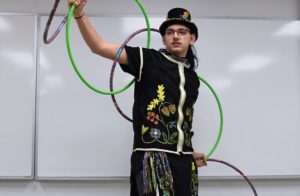Dancers share their passion at Canadore College

By Kelly Anne Smith
NORTH BAY— There was standing room only as teachers, students and members of the Canadore Aboriginal Student Association filled the room to hear a public lecture by River Christie-White and Cody Sackaney about being dancers. The next day was the 30th annual Canadore College Pow Wow.
Christie-White is a hoop dancer of Oneida of the Thames First Nation. Just graduating Grade 12, he is on the way to college. Christie-White explained that the hoop dance originated from the Hopi Nation in Arizona and is moving north as more dancers learn it.
“The style started out as a medicine dance. This dance was used in ceremony for healing— healing communities and making people who are sick better— by asking the spirits to bless the medicine that is inside these hoops and give them out to the people,” explains Christie-White. “The idea of the dance is that every time you pass through one of these hoops that releases the energy that’s inside of them. These hoops go through about a week-long ceremony where they are blessed.”
Christie-White says the hoop dance is all about a story.
“Traditional dancing are all about hunting and gathering and war,” continues Christie-White. “Every formation that we make requires more and more hoops. The more hoops that we use, the more energy is given out to the community. The longest living hoop dancer in Arizona had 108 hoops before he passed away.”
Christie-White says the hoops were originally made of willow and sinew. Each hoop dancer’s routine is unique.

Cody Sackaney began his talk by opening with a song. He explained the significance of the song and about how he made his hand drum.
Sackaney shared his journey to his spirit name which means Little Bear. Sackaney is Timiskaming First Nation and of the Bear Clan. He talked with his Eagle Feather which he said shows respect and truth.
Living a life of sobriety, he gave himself the goals of becoming a Grass Dancer, learning how to sing, attending ceremonies and going to college. They have all come true.
“Anybody can do it. If you put hard work into it, it will come true,” he says. “There are different teachings about becoming a dancer. You must get your colours and your colours will be on your regalia. I’ve also heard it’s your regalia— you can make it how you want to make it. My colours are red. You go and see an Elder; you get your colours, your spirit name, your clan. I got all those things. He also said my colours are blue so I have some blue on there. And green, so I have some green on there and white, so I got white fringes.”
Sackanay showed his shirt, cuffs and his apron which goes around his pants.
“The reason why I have orange in this orange bandana is because that’s the colour for Residential School. I can relate to it when it comes to my family so I wear it for them.”
He talked about his appreciation to be gifted a headpiece. The roach was held up high for everyone to see. Sackaney explained roaches are handcrafted from porcupine hair. His cost him almost $1,000.
Sackaney demonstrates the footwork for grass dancers.
“Whatever I do on one side, when I go on this side, I’m going to do the same thing.”
Grass dancing originates out west on the Prairies.
“Envision the tall grass swaying back and forth on a windy day. We are mimicking that grass. Grass dancers flattened grass to set up teepees or in setting up ceremony,” explains Sackaney. “The reason why we are doing that is we are blessing the ground. We are praying when we dance. When you are really into, you get a feeling you can’t describe it…When someone asks me how to go about being dancer, I say just do it.”


